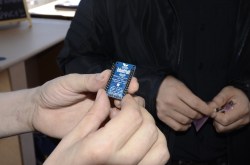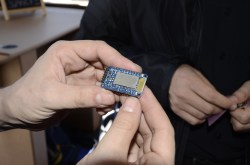
You always meet the most interesting people wandering around Maker Faire, but by far the most interesting was Hackaday’s founder, [Phil Torrone] and bubblegum-haired compatriot [Limor] from Adafruit. They were out in full force checking out the sights and gave us the scoop on a new piece of hardware they’re releasing called Bluefruit.
Bluefruit is a very tiny and very cheap Bluetooth module breakout board that allows anyone to take 12 digital inputs and turn them into a Bluetooth HID device. If you’re planning a portable battery-powered arcade controller, just plug in a Bluefruit, set up your keypresses in your software, and rock out.
On board the Blufruit are an FTDI programming connector, 12 input pins, a few power pins, a custom FCC and CE certified CSR Bluetooth module, and that’s about it. If you’re looking for a simple GPIO to Bluetooth adapter without an overwrought Arduino setup, this is the best solution we’ve seen by far. Adafruit is also rocking their own custom firmware for the device, so this will be extremely hacker-friendly.
The price will be $20 and should be available in the Adafruit store in a bit. If you’re looking for an easy way to put a Bluetooth HID controller in your next project, this is the one.
Pictures of the Bluefruit and Adafruit crew below.



















Could I just wire up every button on an NES controller to the inputs from vcc and have this magically work?
Pretty much looks like it, yes!
If you don’t mind ripping the controller open, and just wire direct to the buttons, sounds like it should work to me. There are pics of the controller’s PCB on the web with points highlighted that you could solder your wires to. If all else fails, each button has a connection to the single chip that’s in there.
I can’t wait to try this.
Shame it can’t handle any analog sticks though
hackaday.com/2004/09/05/radioshack-phone-dialer-red-box/
I discovered HaD in January of this year (2013) so naturally I’ve always been curious about the very first HaD post, this post helped me find it.
I couldn’t help but notice a few things:
1. I am 9 years late
2. The very first post fittingly looks like a Retrotechtacular post.
3. It took more than a month for the first comment.
4. The tape on the picture vertices.
5. Is the circuit in the picture some prehistoric SMT dinosaur?
6. RadioShack was the first HaD “victim”.
7.From what [Frogz] says, I’m not the only one who faced difficulty finding the very first post, (could the HaD editors please put a pointer to that on the home page for the benefit of others like me?)
9. It took seven years for [Frogz] to learn how to build a nest (he’s an amphibian so I don’t blame him).
10. HaD – I mean had- this hack been posted today, a huge war about its legality/illegality
/educational value might have ensued.
11. No videos
12. [Phillp Torrone] jinxed all future HaD editors by starting ALL his sentences with small letters.
13. I have digressed…big time! :D
http://www.hackaday.com/2004/09/05/radioshack-phone-dialer-red-box/
Sorry for the bad link.
We’ll have to do something for our tenth anniversary.
I thought of that too! The first post that day could
read:”Hacking a Decade” or “Hark a Decade” or
something similar. :)
Actually, as far as your #12, for several years, HaD had a simple shout filter that forced all posts to be all lower case. At the same time, they had all images rendered black and white. If you are looking through old posts, you’ll notice there are no caps until there are color photos.
Thanks for the info. :)
Common USB Bluetooth adapters cost like $1 now. I’m thinking a more interesting way to go would be to design as simple as possible of a USB host in a MCU that can use those.
Those $2 USB/bluetooth adapters are USB client only. You would have to connect a USB host to GPIO adapter to it. Some low-cost microcontrollers can do it with the right software or firmware. There might even be an FTDI chip that will do it. Maybe that’s what the Adafruit thing is? Dunno.
I’ve seen them for 35c. I’d guess that a lot of the brains in organising the Bluetooth data and running the spectrum-spreading is done on the host CPU by the driver. Like those “soft-modems” from the 1990s. Leaving the dongle itself to be not much more than a dumb tunable radio rx / tx. I could be wrong though.
I’d like to see one taken apart, and some technical details. For one thing where do they even fit the damn chip!?
This adafruit thingy is FCC and CE approved though, those 50 cent chinese ones might print some FCC/CE logo on them, but those are fake.
Doesn’t bother me, long as they work. I figure they’re going to use the same hardware everyone else does. It’s not like there’s a manufacturer of noisy, overheating Bluetooth chip dies out there for them to use.
I suppose there’s the possibility of them using stolen reject chips, but the bother of testing them is more trouble than buying proper ones. So I can’t see how, in this case, you could do worse. There must only be a couple of places actually fab the silicon, and in a complex microchip like this, it’s either gonna work or not work. If it doesn’t there’s a spare one in my drawer and the pound shop in town has dozens of ’em.
Could be wrong…
I thought of that too! The first post that day could read:”Hacking a Decade” or “Hark a Decade” or something similar. :)